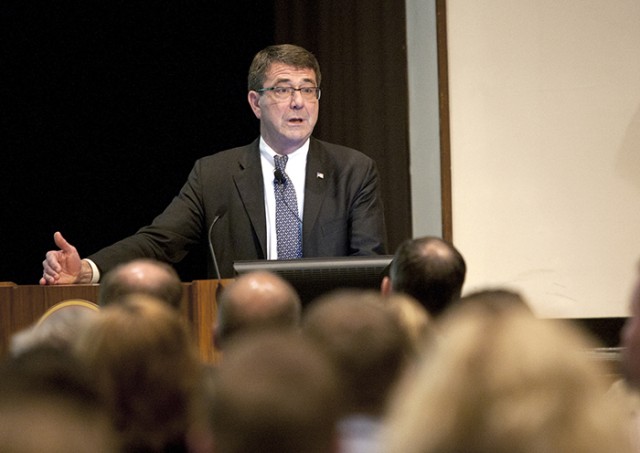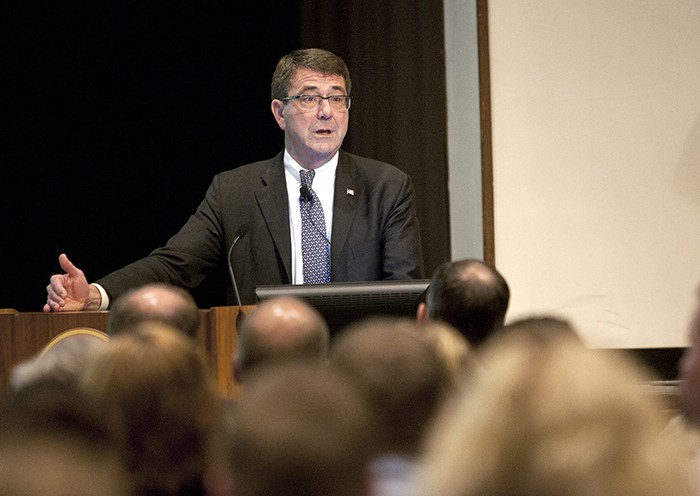PICATINNY ARSENAL, N.J., May 9, 2011 -- Against the backdrop of slower increases in defense spending, the Pentagon must act quicker and focus on wringing more efficiencies and value out of taxpayer dollars, the Undersecretary of Defense for Acquisition, Technology, and Logistics recently told Picatinny Arsenal employees.
Speaking May 3, 2011, at the Lindner Conference Center, here, Ashton B. Carter gave a candid and sweeping assessment of the need to revamp outdated processes and take a fresh look at how the Department of Defense can improve its performance.
"We need an institutionalized fast lane," Carter said, as opposed to a "break-down" lane that has evolved over time in which delays in weapon programs tend to stretch out and costs balloon.
Carter noted that in contrast to the decade after the 9/11 attacks on the United States, the defense budget can't be expected to grow at continuous double-digit levels as in recent years.
"Those days are over," he said.
What that means for managers in the Defense Department is that when they have technical or managerial problems, or difficult choices arise, "we're not going to get out of it by reaching for more money," Carter said.
"It also means that the taxpayer is going to be looking to us to make the best use of each and every dollar that they feel that they can afford to give us," he added.
The undersecretary told Picatinny employees that he understood that the current system does not make their jobs any easier in supporting the warfighter.
"We have an acquisition system and decision-making system that is very slow, very painstaking, very risk-averse, seeks perfection and certainty -- and that's just out of the question in a circumstance like a war where you're trying to react on a scale of weeks and months," Carter explained.
As a consequence, employees have had to "hot-wire" the system or get waivers to do what they can to expedite the process.
Carter related a comment by Secretary of Defense Robert Gates when he offered Carter his current job.
"He said, 'Ash, the troops are at war and the Pentagon is not, especially your part (acquisition). And I want that to change.'"
Carter said he recognized that Picatinny employees know what's important and urgent, and that undue delays in the system translate into lives and missions put at risk.
No major new defense programs will be started unless he can determine how the country is going to pay for them, Carter said.
"No 'bridges to nowhere,'" he added. "And we've had a lot of them in recent times."
When it comes to designing new weapons systems, it's important to look at what design features are driving costs higher and whether they are really needed without compromising critical military capability, Carter said.
That approach needs to be taken with every new weapon systems, although the undersecretary noted that some programs have been under way for some time.
"For all those things that we are in the middle of, we need to drive down costs wherever we can," he said.
"So we have to get cost that has crept in 'the decade of plenty' out of our programs and activities," Carter added, referring to the decade after the 9/11 attacks when budgets grew briskly.
In other areas of potential savings, Carter said the Pentagon is spending $200 billion a year on the acquisition of services, although the $100 billion spent on acquisition gets all the attention.
The spending for services is simply too large to ignore and the large sums reflect the fact that most of the acquisition of services is done by personnel whose principal skill set or responsibility is not in acquisition, Carter said.
"It's not surprising that they're not very good at it," he said. "But we're paying dearly for that. We need to help them do better."
Carter said cutting costs can't be viewed in isolation without considering the people and training needed to perform acquisition better.
"None of this matters without good people," he said, adding that development of the acquisition workforce is needed to ensure "good buying power."
"We have to make sure that we fill out the skill sets where we are thin," Carter added.
In answer to a question from the audience, Carter said it's important to give in-house developers or designers the opportunity to perform work that may be automatically sought from external suppliers.
"Over time, it's hollowing out our own capability," Carter said in describing what he called too much thinking by RFP (request for proposals).
The undersecretary said the Department of Defense needs to have talent that is just as good as what is available in private industry.
Related Links:
Army reviews acquisition process
Army leaders emphasize efficiency in modernization
Army says 'generating force' should not be cut further
Army.mil: Science and Technology News


Social Sharing